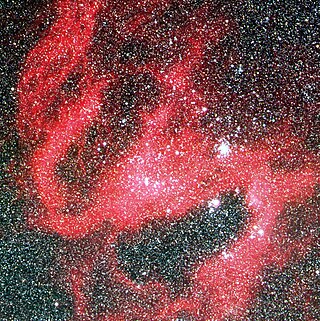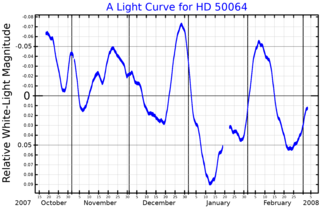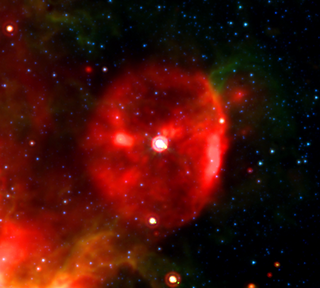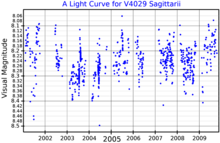
S Doradus is one of the brightest stars in the Large Magellanic Cloud (LMC), a satellite galaxy of the Milky Way, located roughly 160,000 light-years away. The star is a luminous blue variable, and one of the most luminous stars known, having a luminosity varying widely above and below 1,000,000 times the luminosity of the Sun, although it is too far away to be seen with the naked eye.

Luminous blue variables (LBVs) are massive evolved stars that show unpredictable and sometimes dramatic variations in their spectra and brightness. They are also known as S Doradus variables after S Doradus, one of the brightest stars of the Large Magellanic Cloud. They are considered to be rare.

P Cygni is a variable star in the constellation Cygnus. The designation "P" was originally assigned by Johann Bayer in Uranometria as a nova. Located about 5,300 light-years from Earth, it is a hypergiant luminous blue variable (LBV) star of spectral type B1-2 Ia-0ep that is one of the most luminous stars in the Milky Way.

A yellow hypergiant (YHG) is a massive star with an extended atmosphere, a spectral class from A to K, and, starting with an initial mass of about 20–60 solar masses, has lost as much as half that mass. They are amongst the most visually luminous stars, with absolute magnitude (MV) around −9, but also one of the rarest, with just 20 known in the Milky Way and six of those in just a single cluster. They are sometimes referred to as cool hypergiants in comparison with O- and B-type stars, and sometimes as warm hypergiants in comparison with red supergiants.

AG Carinae is a star in the constellation Carina. It is classified as a luminous blue variable (LBV) and is one of the most luminous stars in the Milky Way. The great distance and intervening dust mean that the star is not usually visible to the naked eye; its apparent brightness varies erratically between magnitude 5.7 and 9.0.

HD 37974 a variable B[e] hypergiant in the Large Magellanic Cloud. It is surrounded by an unexpected dust disk.

HR Carinae is a luminous blue variable star located in the constellation Carina. It is surrounded by a vast nebula of ejected nuclear-processed material because this star has a multiple shell expanding atmosphere. This star is among the most luminous stars in the Milky Way. It has very broad emission wings on the Balmer lines, reminiscent from the broad lines observed in the spectra of O and Wolf–Rayet stars. A distance of 5 kpc and a bolometric magnitude of −9.4 put HR Car among the most luminous stars of the galaxy.

A hypergiant (luminosity class 0 or Ia+) is a very rare type of star that has an extremely high luminosity, mass, size and mass loss because of its extreme stellar winds. The term hypergiant is defined as luminosity class 0 (zero) in the MKK system. However, this is rarely seen in literature or in published spectral classifications, except for specific well-defined groups such as the yellow hypergiants, RSG (red supergiants), or blue B(e) supergiants with emission spectra. More commonly, hypergiants are classed as Ia-0 or Ia+, but red supergiants are rarely assigned these spectral classifications. Astronomers are interested in these stars because they relate to understanding stellar evolution, especially star formation, stability, and their expected demise as supernovae.

Zeta1 Scorpii is a B-type hypergiant star in the constellation of Scorpius. It has an apparent visual magnitude which varies between 4.66 and 4.86. It is a member of the Scorpius OB1 association, and the open star cluster NGC 6231, also known as the "Northern jewel box" cluster. Around 36 times as massive as the Sun, it is also one of the most luminous stars known in the Galaxy, with an estimated bolometric luminosity of around 850,000 times that of the Sun and a radius 103 times that of the Sun.

V4381 Sagittarii is a variable star in the constellation Sagittarius. A white supergiant of spectral type A2/A3Iab, it is an Alpha Cygni variable that varies between apparent photographic magnitudes 6.57 and 6.62. Its visual apparent magnitude is about 6.54.

HD 33579 is a white/yellow hypergiant and one of the brightest stars in the Large Magellanic Cloud (LMC). It is a suspected variable star.

HD 168625 is a blue hypergiant star and candidate luminous blue variable located in the constellation of Sagittarius easy to see with amateur telescopes. It forms a visual pair with the also blue hypergiant HD 168607 and is located to the south-east of M17, the Omega Nebula.

HD 160529 is a luminous blue variable (LBV) star located in the constellation of Scorpius. With an apparent magnitude of around +6.8 cannot be seen with the naked eye except under very favourable conditions, but it is easy to see with binoculars or amateur telescopes.

HD 50064 is a blue supergiant located in the constellation of Monoceros, easy to see with small telescopes.

AS 314, also known as V452 Scuti, is a protoplanetary nebula once believed to be a white hypergiant star or luminous blue variable located in the constellation of Scutum. It has an apparent magnitude of 9.85 and can be seen with small telescopes.

HDE 316285 is a blue supergiant star in the constellation Sagittarius. It is a candidate luminous blue variable and lies about 6,000 light years away in the direction of the Galactic Center.

R71 is a star in the Large Magellanic Cloud (LMC) in the constellation Mensa. It is classified as a luminous blue variable and is one of the most luminous stars in the LMC. It lies three arc-minutes southwest of the naked-eye star β Mensae.

Westerlund 1-243 or Wd 1-243 is a luminous blue variable (LBV) star undergoing an eruptive phase located within the outskirts of the super star cluster Westerlund 1. Located about 13,400 ly (4,100 pc) from Earth, it has a luminosity of 0.73 million L☉ making it one of the most luminous stars known.

V1936 Aquilae is a blue supergiant and candidate Luminous blue variable located in the nebula Westerhout 51, in the constellation Aquila, about 20,000 light years away. The star was originally identified as a massive star in 2000, and was thought to be an O-type supergiant. However, subsequent analyses have shown it to be not O but B-type, as well as being possibly an LBV.

B324 is a yellow hypergiant in the Triangulum Galaxy, located near the giant H II region IC 142 around 2.7 million light years away. It is the brightest star in the Triangulum Galaxy in terms of apparent magnitude.





















